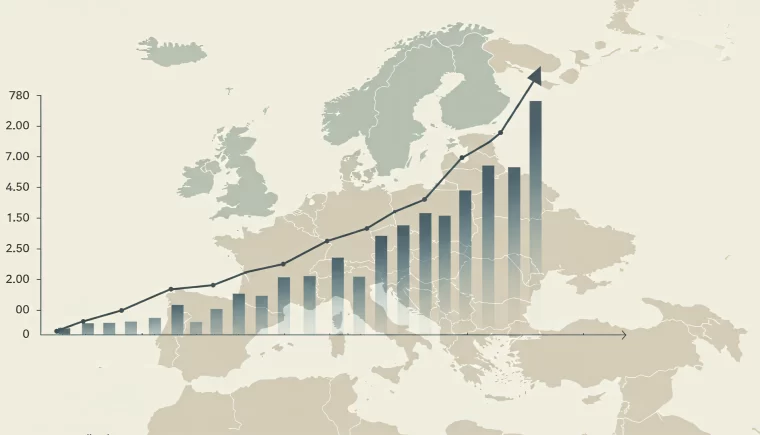How does financial literacy affect business in Europe?
Financial literacy in Europe strengthens entrepreneurship, boosts SME survival, and accelerates economic recovery. Regions with higher financial knowledge show 28% more business resilience and 33% higher startup rates, according to the European Investment Bank and OECD.
This article explores how financial education drives innovation, reduces risk, and creates competitive advantages across European markets.
Financial Literacy Levels Across Key European Nations
Financial literacy in Europe varies significantly by region, creating diverse business environments with unique challenges and opportunities. Nordic countries lead with literacy rates around 65-70%, while southern and eastern regions often range between 35-45%, according to the OECD’s International Survey of Adult Financial Literacy.
These disparities directly impact how businesses operate in different markets. In Finland, where approximately 67% of adults demonstrate strong financial literacy, companies can introduce more sophisticated financial products. Meanwhile, businesses in regions with lower literacy rates often need to invest in consumer education alongside their product offerings.
What is the financial literacy gap in Europe?
Only 50% of EU citizens meet basic financial literacy standards, says Bruegel. Northern countries score higher, while Southern and Eastern regions lag behind. This gap shapes how people use banks, apps, and financial tools. For businesses, adapting to local knowledge levels is now essential.
Several factors influence these regional differences:
- Education system priorities and curriculum design
- Cultural attitudes toward financial discussions
- Historical economic experiences shaping behaviors
- Access to quality financial information resources
How European Education Affects Financial Literacy
Educational approaches to financial concepts vary dramatically across Europe, directly affecting consumer behavior and business opportunities. The Netherlands integrates financial education from primary school onward, while many southern European countries provide minimal formal financial instruction.
This educational divide creates distinct consumer populations with different financial behaviors and product preferences. Companies in the technology sector have responded by developing market-specific approaches to product design and customer education.
How Financial Knowledge Drives Business Growth
Financial literacy creates tangible business advantages by enabling more informed decision-making at both consumer and company levels. When populations better understand financial concepts, businesses benefit through multiple channels.
OECD surveys consistently show that SMEs in financially literate regions report stronger growth and better loan access. These advantages reflect how financial knowledge fosters business resilience, enabling firms to navigate challenges and scale more sustainably.
How Financial Skills Influence Small Business Success
Regions with higher financial literacy consistently produce better-prepared entrepreneurs. Solid financial knowledge helps founders manage cash flow, access funding, and build sustainable business plans—key factors in reducing failure rates. Studies confirm that financial capability is a critical driver of new business formation, especially in regions where financial education is prioritized.
This correlation exists because financially literate entrepreneurs:
- Create more realistic business plans with achievable projections
- Make smarter decisions about funding sources and timing
- Manage cash flow more effectively during vulnerable early stages
- Identify and address financial risks before they become critical
Sweden’s thriving startup ecosystem exemplifies this principle, with comprehensive entrepreneurial financial education programs supporting one of Europe’s most dynamic business environments.

How Financial Literacy Shapes Consumer Confidence
Individuals with strong financial literacy are more likely to invest, adopt efficient saving tools, and take calculated financial risks. This knowledge supports long-term decision-making and fosters active participation in financial markets, reinforcing both personal confidence and economic stability.
For businesses, this translates to:
- Larger addressable markets for innovative products
- More informed customer bases ready for advanced offerings
- Greater willingness to engage with digital solutions
- Stronger trust relationships supporting customer loyalty
Bridging Financial Knowledge Gaps in Europe
There’s still a significant gap in financial literacy across Europe, which shapes how businesses need to respond. The S&P Global FinLit Survey highlights that European countries show varying levels of financial literacy, with northern nations generally scoring higher, while southern countries face greater challenges.
These differences affect how people handle money, trust financial tools, or even plan ahead. That’s why using the same strategy in every market often falls flat. What works in Sweden probably won’t land the same way in Spain.
So here’s the move: tailor your product, message, and education to each region’s financial comfort zone. People connect better when it feels like you’re talking their language—not just selling.
The Role of Digital Tools in Financial Literacy Growth
People use more digital financial tools where financial literacy is stronger. That’s because understanding money makes it easier to trust new things. So, in places where folks feel more confident managing their finances, they’re more likely to use online banking, mobile wallets, or investment apps. And really, wouldn’t you feel the same?
This digital divide affects business opportunities through:
- Varying fintech innovation potential across regions
- Different e-commerce payment preferences and completion rates
- Uneven consumer readiness for automated services
- Regional differences in digital transformation capabilities
Estonia demonstrates how addressing this connection accelerates growth. Through its comprehensive digital literacy program that includes financial components, Estonia has achieved 99% digital banking adoption, creating one of Europe’s most vibrant financial technology ecosystems.
Source: Invest in Estonia
Proven Financial Education Models Fueling Business
Several European nations have implemented effective financial education approaches with measurable positive impacts on business environments. These success stories provide valuable lessons for expanding financial literacy continent-wide.
The Netherlands’ “Money Wise” platform—a collaboration between government, financial institutions, and educational organizations—has reached 87% of Dutch citizens. Since its launch, the Netherlands has seen a 26% increase in household investment participation and a 19% decline in problematic consumer debt, creating a healthier market for businesses.
How Public-Private Models Advance Financial Literacy
The most successful financial literacy initiatives leverage collaboration between governments, businesses, and educational institutions. According to the European Banking Federation, programs with multi-stakeholder involvement show 56% better knowledge retention than government-only initiatives.
These partnerships combine public sector reach with private sector practical knowledge, creating more relevant and engaging educational experiences for participants.
Building Financial Resilience for Business Success
Financial literacy significantly enhances economic resilience, creating stable business environments that can withstand market fluctuations and economic shocks. This stability provides the foundation businesses need for confident growth planning.
Regions with higher financial literacy recover faster from economic downturns and experience less consumption volatility. This advantage helps businesses thrive, as financial education improves decision-making and boosts economic resilience. Understanding finances allows both individuals and companies to navigate market fluctuations more effectively. Investing in financial education is key to stability and growth, especially during tough times.
Frequently Asked Questions About Financial Literacy in Europe
Which country has the best financial literacy in Europe?
Denmark currently leads Europe in financial literacy with approximately 71% of adults demonstrating strong financial knowledge and behaviors, according to the OECD’s International Survey. Nordic countries consistently occupy top positions, with Norway (70%) and Sweden (68%) following closely behind. These nations share common elements: comprehensive school-based financial education, strong public-private partnerships, and culturally open attitudes toward financial discussions.
What is the literacy rate in Europe compared to financial literacy?
While general literacy across Europe exceeds 99% according to UNESCO data, financial literacy averages only about 52% across EU member states based on S&P Global FinLit Survey measurements. This significant gap highlights that reading ability alone doesn’t ensure understanding of financial concepts, demonstrating that specific financial education remains necessary regardless of overall educational attainment.
What is the meaning of financial proficiency in European contexts?
In European policy frameworks, financial proficiency encompasses the ability to make informed and effective decisions regarding money management, investment, and long-term financial planning. The European Banking Authority defines it through mastery of five core competencies: budgeting, saving, borrowing, investing, and financial risk management. Financial proficiency extends beyond basic literacy to include practical application of knowledge in complex financial situations.
How do financial literacy levels affect European business environments?
Financial literacy significantly impacts business environments through multiple channels. The European Investment Bank’s research demonstrates that regions with financial literacy rates above 60% show 29% higher rates of small business formation, 25% better SME survival rates, and 21% higher levels of business innovation compared to regions below 40%. These differences create distinctly different operating environments affecting consumer behavior, workforce financial wellness, and capital availability.
Financial literacy is reshaping Europe’s business landscape by creating more informed consumers, resilient entrepreneurs, and innovative markets. As financial education initiatives continue expanding across the continent, the business opportunities they generate will only grow more significant.
What financial literacy initiatives have you encountered in your region? I’d love to hear your experiences in the comments below.





